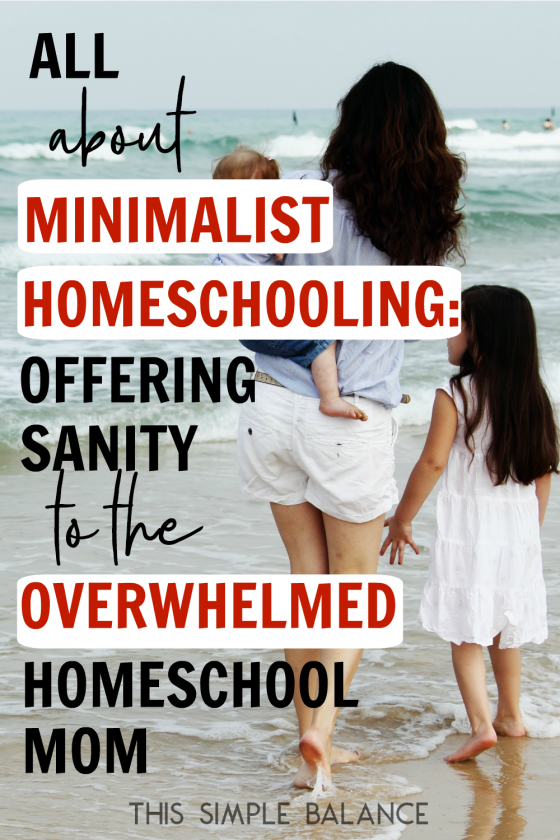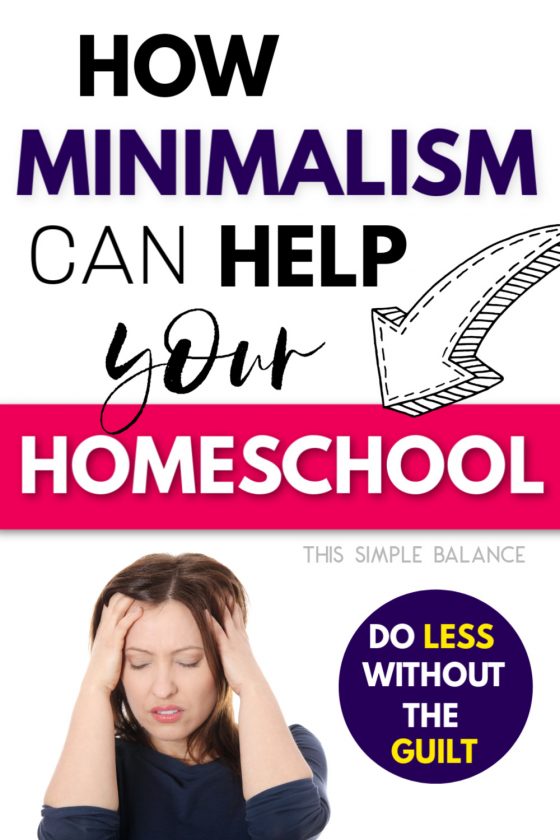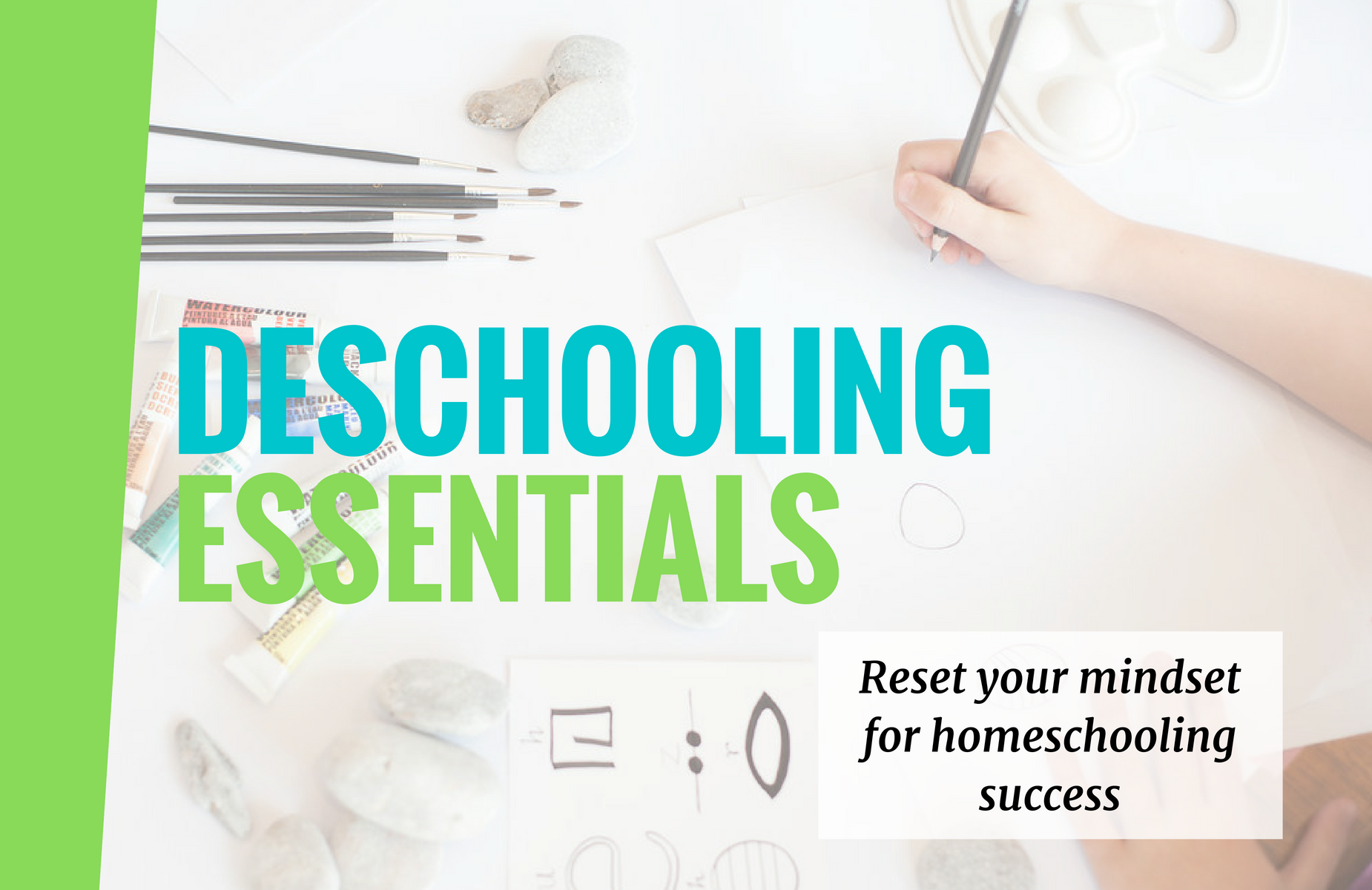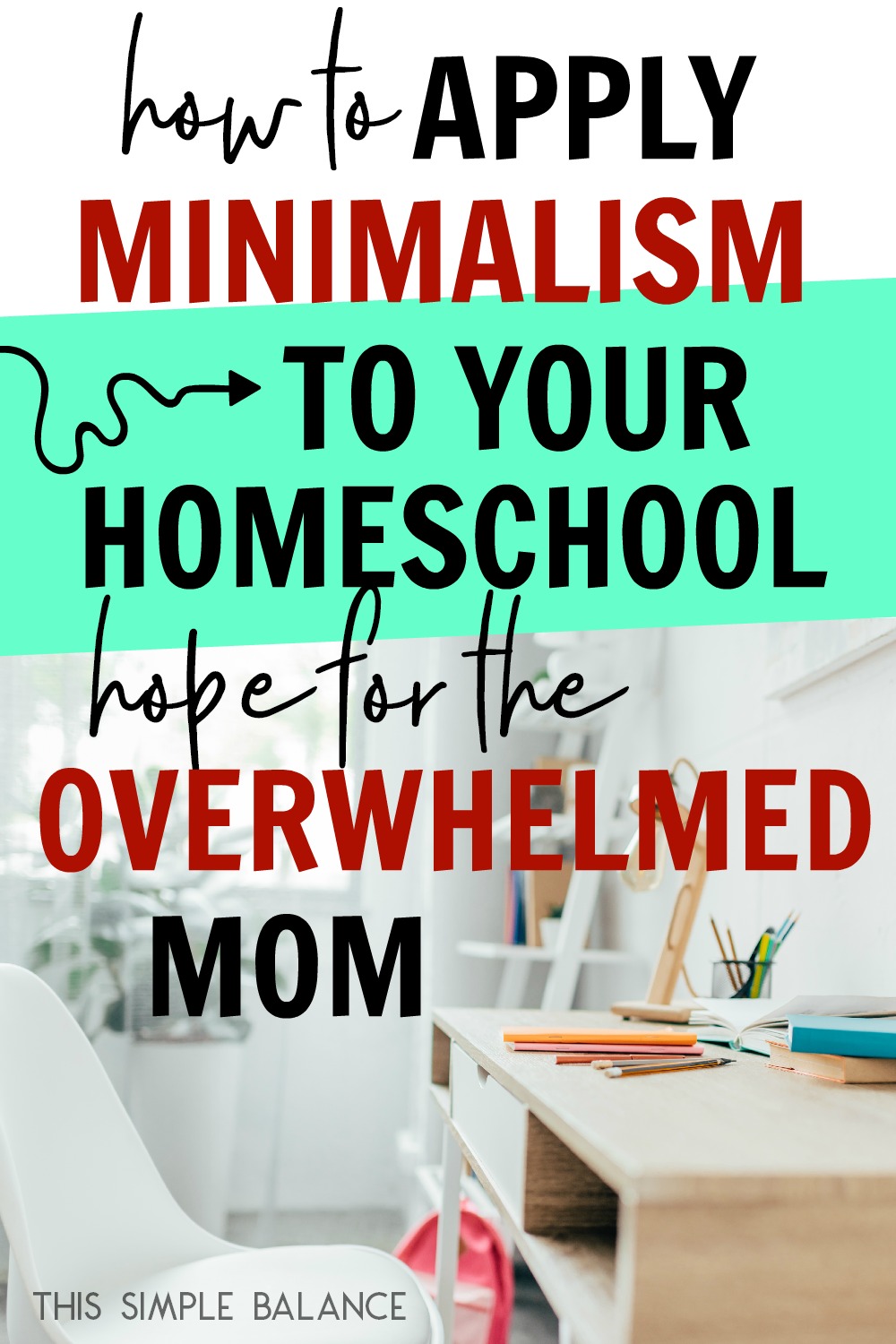Inside: Are you an overwhelmed homeschool mom? Minimalist homeschooling can give you the tools to change that.
Last year, another minimalist blogger and I chatted about the directions I could take this little blog. She brought up that many minimalist families she knew also homeschooled and were looking for direction on how to apply minimalism to homeschooling.
She suggested that I help them do just that: create a course on minimalist homeschooling – how to use the basic principles of minimalism to calm the chaos that homeschooling can be when you’re trying to do all.the.things.
I hesitated for a long time because relaxed homeschooling is my primary homeschool style, and I wasn’t sure what I could really say about minimalist homeschooling.
But after thinking about it for over a year, I realized that I do apply minimalism to my homeschool. Once you start living a minimalist lifestyle, minimalism tends to seep into every corner of your life in a good way because it’s just that beneficial (especially for moms).
There’s no course coming anytime soon, but minimalist homeschooling has SO much to offer the overwhelmed homeschool mom, I couldn’t help but share as much as I can in one blog post.

Who is Minimalist Homeschooling For?
THIS POST PROBABLY CONTAINS AFFILIATE LINKS. AS AN AMAZON ASSOCIATE, I EARN FROM QUALIFYING PURCHASES. YOU CAN READ OUR FULL DISCLOSURE POLICY HERE.
First of all, not everyone wants what minimalism offers – and that’s o.k.!
I have friends who know about my minimalist journey, and they honestly aren’t interested. That’s why I love sharing about my journey here, so that people who need and crave a life of less can figure out how to get started.
However, just like I believe the everyone can benefit from minimalism, I believe that every homeschooler can benefit from minimalist homeschooling.
Let me ask you a few questions:
- Do you feel like you’re going crazy trying to do everything everyone says you “should” do in your homeschool – from the government, to the homeschool veteran, to your homeschool mom bestie?
- Do you crave a slower, simpler life, yes, even in your homeschool, but you’re not sure what to cut and what to keep?
- Are you spinning so many plates as a homeschool mom that you often find yourself overwhelmed and asking, “Do I really need all these plates in the first place?”
If you answered, “Heck yes!” to any or all of these questions, then minimalist homeschooling has SO much to offer you.
Just as minimalism can give you the tools you need to bring clarity, peace and purpose to your physical space (and eventually your calendar, too), minimalist homeschooling offers you very similar tools to bring clarity, peace and purpose to your homeschool.
Minimalist Homeschooling: What It’s Not
To clear this up, here are several things that minimalist homeschool ISN’T.
Minimalist Homeschooling is not less just for the sake of less.
Have you ever read about the minimalists who count the number of items they own and the number of things they’ve decluttered? While numbers can be inspiring, at times it seems like the competition to own more has simply swung the opposite direction to a competition to own less.
Minimalist homeschooling doesn’t tally the number of activities and reduce to the lowest possible number. Instead, it advocates for creating a homeschool schedule based on your goals and values.
There is no glorified or “right” number of hours or activities.
Minimalist homeschooling is not lazy homeschooling.
Much like relaxed homeschooling, some people assume that doing less formal school work – sometimes much less than the traditional school – means you’re lazy and not giving your kids the best possible education.
The world as a whole seems to operate on the idea that more is always better and busier is a badge of honor. To do less on purpose is extremely counter-cultural and therefore, often misunderstood.
Minimalist homeschooling is not a homeschool style in and of itself.
I debated whether I was a relaxed homeschooler versus a minimalist homeschooler for a long time because I didn’t understand that minimalist homeschooling is not a style in and of itself.
Minimalist homeschooling simply applies the principles of minimalism to homeschooling, and all homeschoolers with a variety of styles can benefit from minimalist homeschooling.
From the classical homeschooler to the unschooler, minimalist homeschooling offers the same benefits, and its principles can be applied no matter your style.
Minimalist homeschooling is not just about the physical stuff in your homeschool.
I’ve read multiple blog posts about minimalist homeschooling, and most of them miss the main point.
Just like there is a big difference between someone who regularly declutters and someone who lives a minimalist lifestyle, there is a big difference between a homeschooler who uses fewer homeschool materials and a minimalist homeschooler.
Yes, decluttering your homeschool supplies and materials can be helpful.
Sure, going digital and using your library card fit into a minimalist lifestyle (f.y.i. you can declutter your books, own very few of them, and still raise avid readers).
But minimalist homeschooling is SO much more than that!
Minimalist homeschooling doesn’t just affect what materials you use or how you set up your homeschool space. More importantly, minimalist homeschooling affects what subjects you decide to include from month to month and year to year, and what activities go on your schedule.
Using less physical stuff, while valuable and admirable, is secondary.
And those primary choices – what subjects and what activities – are determined by what you believe is essential to a good education in the first place.
You Might Also Like: Usborne Homeschool Books That Are Actually Worth Buying

So What Is Minimalist Homeschooling?
Minimalist homeschooling is a natural extension of the minimalist lifestyle. Therefore, you really need to understand minimalism before you can begin applying it to your homeschool.
Joshua Becker defines minimalism as, “The intentional promotion of the things we most value, and the removal of everything that distracts us from it.”
Minimalism asks “why” all.the.time. Minimalism never assumes that something (or someone) automatically deserves to:
- take up space in our house
- hold a slot on our calendar
- occupy our thoughts and attention
Minimalism is intentional living in every area of life: your home, your schedule, your thoughts. But everyone has different values; therefore, minimalism will look a little bit different for everyone.
So will minimalist homeschooling, although almost always, it will mean doing less than your typical homeschooler.
Minimalist homeschooling never assumes that any subject or activity is a given, deserving of our precious time and energy. Instead, minimalist homeschooling always starts with what you value – with your family’s end goals for homeschooling.
Activities, subjects, and materials that align with your values and goals (and increasingly more your child’s as they grow older) are added to your homeschool schedule, and no more.
Related: How to Homeschool Kindergarten & Love Your First Year
How to Get Started with Minimalist Homeschooling
1. Start with a blank slate.
One of my favorite minimalist bloggers Myquellin Smith recently wrote a book on interior design called The Cozy Minimalist Home: More Style, Less Stuff. Her suggestions for redecorating rooms are surprisingly (or not surprisingly) perfect for reordering our homeschools.
Before she makes any decisions about how to redesign a room, she first “quiets the room”. She takes everything out: the pictures off the walls, the lamps off the tables, the knick knacks, the blankets, even the furniture!
Only when starting with a completely blank slate can you really see a room for all its possibilities. It also forces you to question everything you put back into it.
Without quieting the room, you spend way too much time picking up every little thing, wondering what needs to go.
Similarly, well-known minimalist Marie Kondo approaches decluttering physical spaces with the default assumption that everything goes. Every single item needs to earn its way back into the home, instead of trying to decide whether or not to keep every little thing.
Unless something stands out to her in the decluttering process as valuable, beautiful, and useful to her, it’s getting donated, sold, or trashed.
So, in order to get the most benefit from minimalist homeschooling, you need to take a week or two off. Clear your schedule, and take a step back.
If you’ve never deschooled, now is a great time to do it! If you’ve already done spent enough time deschooling (although personally, I feel like I’m always deschooling in one way or another), then you still need to mental space and actual time to do the next step.
Need more deschooling guidance? Check out this course by Kelly at Fearless Homeschool: it’s fantastic!

2. Define your homeschool vision and end goals.
If you have no idea why you are homeschooling, you need to figure it out. If you don’t know your family’s educational values and goals, your homeschool schedule will be subject to the whims of your own preferences, what traditional school says you need to do, or what anyone else says you “should” be doing.
Take the time to consider what you want your children to be when they are done homeschooling.
- What do you want them to know?
- What do you want them to be able to do?
- What do you believe will set them up for success?
The answers to these questions are going to determine what you add back into your homeschool.
3. Understand the benefits of doing less.
Just as your home grows and changes over time, so will your homeschool. The physical objects in your home when your kids are small will be quite different than the things in your home when you have teenagers.
In the same way, every year, your homeschool will look different as you progress towards your goals. The subjects you decide to include can, and probably will, vary from year to year.
My favorite part of minimalist homeschooling is the ability to focus on fewer things at a time.
For example, I am purposely ignoring grammar for the time being.
My daughter, technically in third grade (but who’s counting?), loves to write short stories. I occasionally step in to teach or correct grammar.
Often, I help because she asks me to do so. Simply from reading all the time, she knows that something isn’t quite right about the way a sentence looks, and she asks me to fix it. So I do, and briefly explain why I made the change.
By delaying direct grammar instruction, I am in no way saying it’s not important. I do believe that knowing proper grammar is important, to an extent.
However, I don’t believe that grammar deserves little bits and pieces of our divided attention every week for the next 5-6 years.
Instead, I have decided to take one school year – likely fourth or fifth grade – to focus on grammar (we will be using this grammar program, if you’re curious).
Similarly, through reading and research, I’ve decided that becoming a good speller often happens over time just from reading and writing regularly. Often, people are either good or bad spellers innately. Therefore, we don’t do spelling lists, tests, or learn spelling rules at this time (people claim there are rules, but good grief, with all the exceptions in the English language, seriously?).
If my kids need more intensive spelling work later on, I can choose to spend a year focusing solely on spelling to get them up to speed.
Not every subject needs to be done every year, all the time. Minimalist homeschooling gives you the freedom to arrange your schedule in a way that makes sense to you and your family.
It offers you the freedom to do a few things at a time, and to do those things excellently.
Related: Unschooling Language Arts – A Guide for the Elementary Years
4. Stop comparing.
What you decide to keep in your homeschool schedule is really up to you.
If state regulations are flashing through your mind after that statement, unschoolers seem to make it work in just about every state. If they can get creative and figure out how to convey their day to day learning activities in a way that fits state requirements, so can you.
Minimalist homeschooling, like minimalism, is counter-cultural. It chooses to say “no” to adding things for adding’s sake or because someone else says you should.
Stop comparing, and focus on your goals and your homeschool.
5. Trust the process.
When families first start homeschooling, they often start by trying to replicate school at home. Some find that method works for them.
Like me, many others quickly realize that homeschooling isn’t meant to be school at home – nowhere close!
Homeschooling is a lifestyle that should not be confined to a 9-3:30 schedule or a list of every little thing a child should know.
When you decide to pull your kids “off the conveyor belt”, their development and learning will follow a different timeline and path than the average public school student.
Because you have the freedom to teach things in the order you want to teach them, when your kids are ready to learn them, your 10-year-old might not know everything a rising fourth grader is “supposed to know” (decided some random person somewhere who probably wasn’t even an educator).
That’s o.k.!
If they really need to know those things, you’ve given them a love of learning, and taught them how to learn, they will get the knowledge they need. They might learn it in a traditional sense, or in a completely different way than many kids learn it in traditional school.
If they really need it, they’ll get it.
(Do you really still remember all the state capitals and nicknames? Do you need to have that information on a regular basis? Really?)
Embrace the process. Recognize that comparing homeschooling to traditional school is like comparing apples to oranges.
I would encourage you to throw out your “What Every Fourth Grader Should Know” books and follow the educational values and goals you set for your kids.
Trust the process of homeschooling. It’s a journey.
Related: Top 12 Unschooling Books for Rethinking Education

More About Minimalist Homeschooling
I’ve only touched the surface of what minimalist homeschooling really is and what it can do for your homeschool.
Zara Fagen, Ph.D., wrote an entire book about minimalist homeschooling that will take you far more in depth than any one blog post can. I highly recommend her book for any homeschooler wanting to dive deep into all the benefits minimalist homeschooling can offer.
She will literally walk you through every little step WITH examples and questions and worksheets. She’ll take you all the way from the big stuff, like defining your educational values and goals, to the secondary, but still important, decluttering homeschool books and materials.
My only caveat is that if you are also a relaxed homeschooler, like I am, she doesn’t fully get what relaxed homeschooling is and seems to think it’s at odds with minimalist homeschooling. I disagree! Other than that, the book was the most comprehensive guide for minimalist homeschooling I’ve seen yet.
Finally, I just wanted to let you know, overwhelmed homeschool mama: homeschooling is hard work, but it doesn’t have to be that hard.
Do yourself a favor: get the book. Eliminate the overwhelm.
Read Next: 10 Signs Relaxed Homeschooling Is For You (from homeschool bloggers)


Next month, I’ll be as a minimalist for a year now! (I used to be an emotional hoarder!) It’s been a slow process but my house is almost finished! Very little is left! However, a couple weeks ago, it hit me. My house represents minimalism, but my mind does not and nor does my homeschooling. I’m just as stressed mentally with all I want to accomplish with homeschooling. And I still don’t feel I have the time to accomplish all I want in real life, fun stuff with my children, seeing extended family, etc. So, I know it’s time to make some sacrifices. I have children (ages 8,5,3) and married to a farmer, which also keeps me super busy. But I also don’t feel I’m involved with the farm as much as I wish to be, because of my high expectations and details of homeschooling. I know I need to minimize it! And put much more focus on my children personally! Anyways, thanks so much for this article. And I now have that book on my Amazon cart!
Brilliant, it resonates so much with me thank you! I am continually working towards minimalism and now homeschooling so this was a very helpful and practical post!
Love the idea of this! I found your blog today and have read through quite a few of your posts. Just wanted to comment on your choice of using Grammar Galaxy- we started it this year and my boys love it!
So glad you’re enjoying Grammar Galaxy, Meagan!
I about cried when I landed on this page. I didn’t know there was a name for this, but I thank you for putting this post out to the world. I really needed this, right this moment.
I’m so glad Jen! You can do this!
I live in Washington state and for homeschool we are required to cover 11 different subject areas during the “108” days of our school year. How would you approach your year if you had these requirements?
Hi Karla! I read through the state laws for Washington, and they seem fairly flexible to me. It all depends on how you look at it.
The 11 subjects- it didn’t specify how often you need to teach them, at least not that I can see. I would probably be doing the same things I am now, but I would be paying more careful attention to segmenting activities/books/subjects out into their 11 “subjects” (learning is rarely segmented that way – a biography about an artist could count as history, art, and reading). As for the hour requirement, it stated “180 days OR 1000 hours”. I would take that OR pretty liberally and count attendance by day. I count most whole days as school because learning never stops – we probably do “school” 240-250 “days” a year if you don’t count weekends, which you could very well count.
So I guess I’m saying I would probably be doing what I’m doing. 🙂 And we do all the subjects listed in some form or fashion – sometimes they are learning through books, sometimes through workbooks, sometimes through activities, sometimes through educational shows/youtube channels (Scishow kids, for example, is an amazing resource; Wild Kratts is another favorite).
I’m considering homeschooling. I love your idea that grammar and spelling are learned innately by reading but my state requires they be taught formally. I’m not really sure what counts as formal.
Hi Alex! There is generally a lot of leeway with state requirements. When submitting your plans, you can usually formally describe the process of “teaching” them in everyday life, such as “We will read every day for 20 minutes and write every day to practice spelling and learn new spelling words. We will use grade-based spelling lists to periodically assess spelling progress and the need for increased instruction and practice.” That writing can be writing lists, short stories, writing in workbooks, etc. But if you are nervous about compliance (which I totally understand), you can use more laid back curriculum/resources to teach it “formally”. I am going to be using a few Brave Writer Arrow Guides this year to touch on some grammar and writing ideas that I want to make sure my kids know. You can find them HERE. I also plan on writing a post on how we use them once we get there.
I am a minimalist and a homeschooler of 17 years. I agree with most of what your saying but in our state we have to follow certain guidelines especially for high school. They have to take english that includes grammar, spelling, writing, and literature every year, three sciences including biology, three history/social studies to include government/economics, and three math to include geometry and algebra. So you can see we can’t completely exclude something. We do however choose wisely to make sure what we are using or doing with our time is not over the top busy work but the meat and potatoes so to speak of what we need to learn. That way we can spend the rest of our time freely pursuing our interests and talents.
Can we purchase your book anywhere besides amazon?
Not that I know of…I did a quick check on Barnes and Nobles and it’s not there.
Hi June! Thanks so much for recognizing my book here! I’m so glad that you found it helpful. I don’t think necessarily that minimalist homeschooling and relaxed homeschooling are at odds, so much as they are not synonymous. I think people are quick to assume that minimalist homeschooling and relaxed homeschooling are the same, but they’re really not. You can be a very traditional homeschooler, and do it minimally; you can be a relaxed homeschooler, and do it minimally; etc. Minimalist Homeschooling is a mindset shift, not an educational philosophy. I’m sure you kn ow what I mean :). Thanks for making me realize that I needed to clarify that point. Wishing you all the simple things! -Zara
Hi Zara!
Thanks for coming over to comment and clarify. I understand better now where that statement in the book was coming from. Loved your book and can’t recommend it enough! It’s a breath of fresh air for homeschooling moms who need to fewer things well.
Keep preaching the benefits of minimalism in all things!
-June